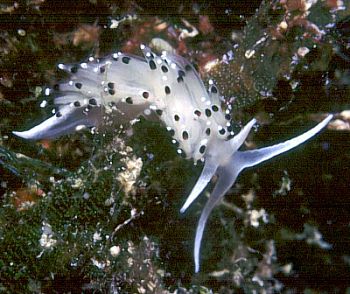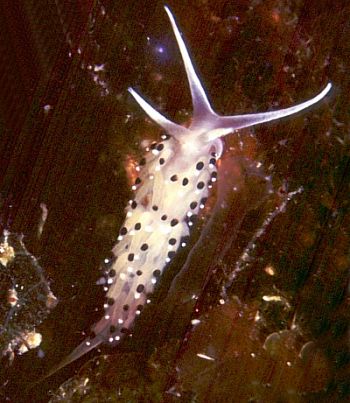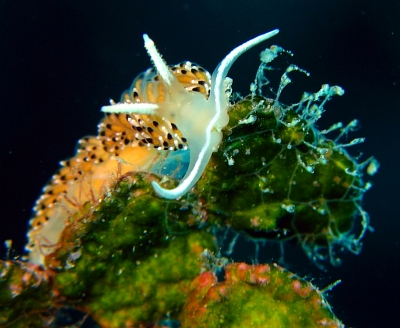

Caloria elegans
(Alder & Hancock, 1845)
Order: NUDIBRANCHIA
Suborder: AEOLIDINA
Family: Glaucidae
DISTRIBUTION
Known from southern British Isles to the western Mediterranean. Reported here from the Aegean Sea (Turkey).
PHOTO
UPPER: Datca, Turkey, 5m. Length approx 15mm, May 1995. LOWER: Bodrum, Turkey, 7m. Length approx 15mm, February 1998. PHOTOS: Baki Yokes.
Animal translucent clear with a white median line on the posterior foot and white pigmentation on the upper two-thirds of the tapering oral tenatcles and rhinophores. Adults from Britain have irregularly distributed small papillae on the posterior face of the rhinophores but these are usually absent in Mediterranean animals. The ceratal digestive gland duct in British material ranges in colour from pink to creamy white and in Mediterranean animals it can also be brown, orange or red. There is a very characteristic black region at the tip of the digestive gland duct and above it there is an opaque white subapical ring on the ceras, partially obscuring the cnidosac. In Britain it can reach 34mm in length but in the Mediterranean it rarely reaches 20mm.
Reference:
• Thompson, T.E. & Brown, G.H. (1984) Biology of Opisthobranch Molluscs, Vol 2. Ray Society: London.
Rudman, W.B., 2001 (September 24) Caloria elegans (Alder & Hancock, 1845). [In] Sea Slug Forum. Australian Museum, Sydney. Available from http://www.seaslugforum.net/find/caloeleg
Related messages
Re: Caloria elegans feeding
March 27, 2009
From: Dominique Horst


Concerning message #21502:
Hi Bill,
To complete Caloria elegans feeding. Here is an animal on a Halimeda plant, feeding on a kind of network of hydroids...
Locality: Antibes, 9 m, France, Mediterranean sea, 22 March 2009. Length: 13 mm. Photographer: Dominique Horst.
Best regards,
Dominique
dominique.horst@wanadoo.fr
Horst, D., 2009 (Mar 27) Re: Caloria elegans feeding. [Message in] Sea Slug Forum. Australian Museum, Sydney. Available from http://www.seaslugforum.net/find/22354
Thanks Dom,
Your photos show the net-like arrangement of tubes which link the individual polyps in this type of hydroid colony.
As I have outlined on the Hydroid Fact Sheet, there is a great variation in growth forms amongst hydroids, some live as solitary individuals, but most are colonial. The most noticeable are those that form quite large colonies which look like fern fronds. However many colonies go unnoticed because the polyps are very small and their small tube-like stalk is joined to its colonial 'relatives' by a meandering network of root-like tubes. We can see these tubes as a thin whitish network in Dominique's photos.
Best wishes,
Bill Rudman
Re: Caloria elegans from the French Mediterranean
July 31, 2008
From: Dominique Horst


Concerning message #20021:
Hello Bill,
These Caloria elegans have a great variation in colour. It's probably, as in many other cases, a result of their food colour. The last two were found at the same place, which means that two individuals, quite the same size and at the same place, are feeding so differently?
Locality: Antibes, 12 m, France, Mediterranean sea, 06 April 2008. Length: 12 mm. Photographer: Dominique Horst.
Kind regards,
Dom.
dominique.horst@wanadoo.fr
Horst, D., 2008 (Jul 31) Re: Caloria elegans from the French Mediterranean. [Message in] Sea Slug Forum. Australian Museum, Sydney. Available from http://www.seaslugforum.net/find/21502
Dear Dom,
In aeolids, the colour in the cerata is certainly related to the colour of their food but I don't know if it is always a direct relationship. In egg-eating aolids [species of Favorinus] the colour in the ceratal digestive gland is definitely the same as the colour of the eggs they are eating, but in small hydroids it may be more difficult to show as it is often difficult to see the polyp colour. Interestingly in your two lower photos of animals which were found together, the 'yellow' one in the middle photo has traces of the orange brown colour of the lower photo, which would suggest the middle one has changed its food source.
In the upper photo, the digestive gland duct in each ceras seems to be almost empty and colourless suggesting the animal has not fed for a while. The orange layer in the body is not part of the digestive gland but is the gonad - the organ which produces the eggs and sperm. I don't know if the colour of the eggs is related to food colour in this example, but I guess it is possible.
Best wishes,
Bill Rudman
Re: Caloria elegans from the French Mediterranean
July 30, 2008
From: Dominique Horst

Hello Bill,
This Caloria elegans is feeding on hydroids, but I am not able to identify the hydroid?
Locality: Antibes, 12 m, France, Mediterranean sea, 06 April 2008. Length: 12 mm. Photographer: Dominique Horst.
Kind regards,
Dom.
dominique.horst@wanadoo.fr



Dear Dom,
One of the biggest problems in studying the biology of nudibranchs is the difficulty in accurately identifying their prey. Almost all their food items -sponges, hydroids, bryozoans, soft corals etc - are groups which need expert assistance in identification. Unfortunately such experts are very scarce on the ground. Looking at your photos they appear to me to be a sequence showing this Caloria 'eating' two stalks of a small hydroid colony. Some aeolids feed by delicately biting off individual polyps as they crawl along the hydroid colony. In other cases, such as here, the aeolid ingests a stalk or branch, stripping or breaking off all the polyps in their individual cases, and then moves on to another branch. This happens in hydroids with small stalks or branches, and small polyps which retract back into their cases. What is left after feeding are the stalks minus the polyps. Once they have fed there is no way to easily identify the hydroid.
Best wishes,
Bill Rudman
Caloria elegans from Malta
July 11, 2007
From: Patricia Peels

Dear Bill,
Just for the records we would like to add this sighting of Caloria elegans from Malta.
Locality: Cirkewwa, 20 m, Malta, Mediterranean, 19 May 2007, wall, covered in algae, sponges etc.. Length: approx. 5 mm. Photographer: Patricia Peels.
Best regards,
Patricia & Gerard Peels
gmpeels@nextgen.net.mt
Peels, P., 2007 (Jul 11) Caloria elegans from Malta. [Message in] Sea Slug Forum. Australian Museum, Sydney. Available from http://www.seaslugforum.net/find/20140Thanks Patricia,
Bill Rudman
Rudman, W.B., 2007 (Jul 11). Comment on Caloria elegans from Malta by Patricia Peels. [Message in] Sea Slug Forum. Australian Museum, Sydney. Available from http://www.seaslugforum.net/find/20140Caloria elegans from the French Mediterranean
June 21, 2007
From: Dominique Horst


Hello Bill,
I've met a new (for me) elegant Mediterranean slug. I suppose this is Caloria elegans in yellow version ? It was moving quickly and it was quite difficult to photograph.
Locality: Cap d'Antibes, 15 m, France, Mediterranean sea, 7 May 2007. Length: 10 mm. Photographer: Dominique Horst.
Kind regards,
Dominique
dominique.horst@wanadoo.fr
Horst, D., 2007 (Jun 21) Caloria elegans from the French Mediterranean. [Message in] Sea Slug Forum. Australian Museum, Sydney. Available from http://www.seaslugforum.net/find/20021
Thanks Dom,
Some of this family of aeolids are the fastest nudibranchs. I am not sure what the rush is, perhaps to get to the next hydroid. I suppose if food is in short supply then finding food can be quite competitive.
And referring to your last mesage [#20020], you will notice that the eyes are quite visible in this species as well. However since the skin is not pigmented, there is no need for 'windows' in the colour pattern.
Best wishes,
Bill Rudman
Caloria elegans from Turkey
November 11, 2005
From: Goker Goksel


Hard to see, hard to photograph...
Locality: Kücük Reef, Bodrum, Mugla, Turkey. Aegean Sea. Depth: 5 m. Length: 5-6 mm. 02 November 2005. Rocky, covered with sea plants... Photographer: Goker Goksel
Thanks for your interest,
Goker
gokerg@yahoo.com
Goksel, G., 2005 (Nov 11) Caloria elegans from Turkey. [Message in] Sea Slug Forum. Australian Museum, Sydney. Available from http://www.seaslugforum.net/find/15206Dear Goker,
Thanks for this photo of a very small Caloria elegans. I guess that is why the head tentacles seem disproportionally large when compared with the length of the body.
Best wishes,
Bill Rudman
Caloria elegans from Turkey
September 9, 2003
From: Ferda Buyukbaykal

Dear Bill,
Is this Caloria elegans?.
Date: August 24, 2003
Location: Mugla-Bodrum
Site: Turgutreis-kargi adasi
Depth: 15m
Size: 12-15mm
Photos: Ferda Buyukbaykal
Best regards
Ferda
ferdabbaykal@isnet.net.tr
Buyukbaykal, F., 2003 (Sep 9) Caloria elegans from Turkey. [Message in] Sea Slug Forum. Australian Museum, Sydney. Available from http://www.seaslugforum.net/find/10917
Dear Ferda,
This certainly looks like Caloria elegans. It is interesting to see these animals crawling together over what I presume is a sponge. I don't think the food of this species is known at present so it is possible that one of its food items is a hydroid which lives in close association with this sponge.
Best wishes,
Bill Rudman
Caloria elegans from French Mediterranean
August 12, 2003
From: Marina Poddubetskaia

Dear Bill,
Here is a record of Caloria elegans from Cerbere.
Date: July 08, 2003
Location: Cerbere, France, Mediterranean coast
Site: Les 3 moines
Depth: 16m
Size: 5-6mm
Photos: Marina Poddubetskaia - Nembro website
Best wishes,
Marina.
nembro@nembro.info
Poddubetskaia, M., 2003 (Aug 12) Caloria elegans from French Mediterranean. [Message in] Sea Slug Forum. Australian Museum, Sydney. Available from http://www.seaslugforum.net/find/10549Thanks Marina,
Bill Rudman
Caloria elegans from Turkey
September 27, 2001
From: Baki Yokes


Dear Bill,
Here are two of my photos of Caloria elegans from Turkey. This species is rarely seen around Turkish coasts, but this is may be due to its small size, and they are more common in warm waters of Mediterranean rather than they are in Aegean. They also prefer shallow waters.
UPPER: Datca, Turkey
Divesite: Inceburun
Depth: 5m
Size: around 1,5cm
Date: May 1995
LOWER: Bodrum, Turkey
Divesite: Poyraz Limani
Depth: 7m
Size: around 1,5cm
Date: February 1998
Best wishes
Baki
bakiyokes@turk.net
Yokes, B., 2001 (Sep 27) Caloria elegans from Turkey. [Message in] Sea Slug Forum. Australian Museum, Sydney. Available from http://www.seaslugforum.net/find/5336Thanks Baki,
Another interesting record. I am not sure f it has been recorded east of the Bay of Naples. Caloria elegans is one of those aeolids in which some of the innermost cerata in each row are much larger than the others, and lie with a curled tip waiting to quickly uncurl the ceras when the animal is disturbed and wriggle it around in a defensive display. Have you seen it do that?
Best wishes,
Bill Rudman
